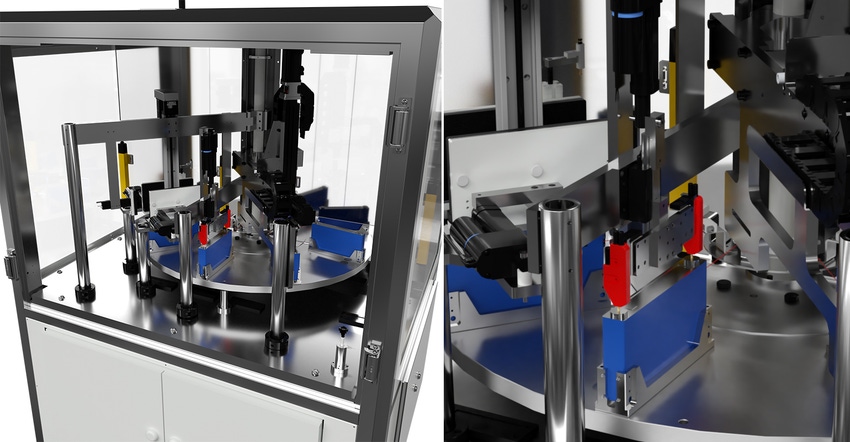Taking the Measure of Battery/Powertrain Production Quality
Quality and process monitoring for battery and electric powertrain components takes more than assessing mechanical parameters and dimensions. Marposs’s EV Industry Manager explains.

Nobody thinks that the powertrain of a standard internal combustion engine (ICE) powered automobile is simple. In fact, the relative simplicity of the electric vehicle (EV) powertrain is considered a great advantage: fewer components means fewer variables to account for. Therefore, quality and manufacturing/assembly process inspection on EVs should be simpler than on ICEs—right?
Not so fast. Assessing the quality of ICE components is largely limited to checking their mechanical dimensions and parameters. Granted, those measurements need to be precise and accurate to the micron level in some cases—but it’s still largely a single kind of activity: whether or not a part is in spec is based on its physical dimensions.
Meanwhile, the “simpler” EV powertrain needs to have more than part dimensions inspected, explained Franco Stanghellini, who is Electric Vehicle Industry manager for test and measurement equipment developer Marposs Corp.
“The performance of battery components, electric motors and fuel cells also depends on the links between their physical, chemical, electric, and magnetic characteristics,” Stanghellini pointed out.
Battery Technology interviewed Stanghellini to learn more about ensuring quality of EV battery and powertrain components at the production level:
What are the current test/measurement challenges facing battery production?
Franco Stanghellini: Quality control and process monitoring are obviously not new topics for the battery sector. However, the increase of electric vehicles and, therefore, batteries, is highlighting the need to change the approach with which these issues are addressed.
The electric vehicle market is only now beginning to take hold. Unlike Internal Combustion Engine (ICE) vehicles, the number of Battery Electric Vehicles (BEV) is still very limited, so there is not enough data and feedback from the field to guide the identification of the major problems.
At this stage, the issue of quality and process control is therefore particularly important. Extreme care must be taken, in order to ensure adequate conditions of safety and reliability, even providing redundant or oversized control mechanisms.
The use of batteries in electric vehicles, first and foremost, requires compliance with the stringent quality standards linked to compliance with safety and reliability conditions. Defects that in other applications can be perceived as “annoying” become unacceptable in automotive applications.
Hence, particular attention should be given to the measurement and inspection for defect detection in electrode production, with particular emphasis on checking the integrity of battery cell sealing with leak testing.
In addition, ensuring battery reliability within the automotive sector requires testing for problems within the context of use. For example, vehicles are exposed to rain, snow, or even car washes so there must be stringent requirements for leak testing of the battery pack. Another example is the battery cells grading before assembly into the module and pack. In order to optimize the BMS [battery management system] operation, battery range, and life expectancy, it’s recommended to assemble cells of the same class with homogenous behavior in respect to some functional parameters—capacity, internal impedance, and so on.
How is Marposs answering those challenges?
Stanghellini: The automotive market has always been one of the Marposs Group’s strategic business sectors. The transition to electromobility is both a major challenge and a great opportunity for us, and Marposs is continuing to be a leading solutions provider for certifying quality in the automotive market.
Traditional product lines have been integrated with new technologies to provide a mixture of measurement, inspection and testing solutions that ensure complete monitoring of the main electric vehicle components’ production process. These range from batteries to fuel cells and electric motors to complete Electric Drive Units.
Unlike the ICE, quality control and process monitoring for electric powertrain components cannot be limited to an assessment of mechanical parameters and dimensions. The performance of battery components, electric motors and fuel cells also depends on the links between their physical, chemical, electric, and magnetic characteristics. It is therefore essential to build interdisciplinary skills and use them to develop products and application solutions that can be integrated into the production line.
Marposs has prepared for this challenge by studying the process required to create an electric car and investing in collaborations with universities, internal R&D activities, and companies with specific know-how and a portfolio of products and dedicated applications. We have also created Competence Centers for developing innovative measurement, inspection, and testing solutions for the various electric powertrain components, as well as offering training activities for the sales and service network.
From ICE to EV production challenges
How is the transition from traditional gasoline-powered automobiles to EVs affecting production and assembly from your perspective?
Stanghellini: We are witnessing a great revolution involving various industrial sectors.
On one hand, the world of car manufacturers and the entire T1 and T2 supply chain are faced with radically different technologies from those that have characterized ICE mass production for more than a century. New skills need to be developed and shared within the entire organization, from the engineering stage to the manufacturing plants.
On the other hand, opportunities are opening up for companies that have traditionally operated in completely different industrial sectors—such as battery manufacturers, who for the first time are facing the problems of use and the quality standards imposed by the automotive market.
In either case, none of the major players can boast long-standing application experience in the sector. In this context, Marposs proposes itself to our customers as a global partner for quality and process control, capable of solving measurement, inspection, and testing problems by providing turnkey applications along the entire production chain. A large portfolio of proprietary products and technologies is combined with specific application skills and long-standing experience as a supplier to the automotive market.
Smart Manufacturing
How is Industry 4.0 technology changing what your customers expect from you?
Stanghellini: Marposs currently offers a wide range of applications for monitoring, testing and measurement, distributed through the entire production process.
With the Industry 4.0 revolution, our customers are expecting all our applications to be able to communicate and interact with each other, providing data that can be collected, consulted and analyzed from a single repository.
Collecting data in a central platform allows correlations among all production steps to be identified and, once these links have been identified, actions on the production processes can be anticipated, minimizing scrap parts and optimizing production lines. These correlations, if not evident, can be identified using AI algorithms that work on the aggregated data.
Marposs has created MAINDO (“mind” in Japanese), a digital platform that can manage all this data. This platform is able to aggregate very different types of data: data from machine tool sensors (vibration, temperature, power, ...), both in- and post-process dimensional measurements, and electrical or leak testing parameters, as well as completing what Marposs internally calls TOTAL QUALITY, information from our Quality Management System (compliance, supplier, ...)
MAINDO is designed to provide a holistic view of production processes and thus is not limited to Marposs devices but can also aggregate information from third parties. The Marposs digital platform can manage in-cloud or on-premises architecture, allowing effective scale up as the organization grows and changes. Its web-based nature allows data access from any connected mobile device.
Finally, can you describe one of your newer solutions?
Stanghellini: As mentioned, the specific added value proposed by Marposs involves the wide range of skills and technologies and the ability to integrate them into turnkey applications.
In this case, we are talking about a semi-automatic machine dedicated to the complete qualitative analysis of prismatic battery cells. This machine can be easily reconfigured to adapt to different cell sizes and is suitable both end of line control or verification and grading at the beginning of a module assembly line.
The cell’s main dimensional parameters are checked using contact or chromatic confocal technology.
The main functional electrical parameters, such as Open Circuit Voltage (OCV) and Alternating Current Internal Resistance (ACIR), are then measured. Other measurements such as Direct Current Internal Resistance (DCIR) or complete Electrochemical Impedance Spectroscopy (EIS) can be made at the customer's request.
Then, the perfect electrical insulation is checked (Hi-Pot test), by contacting all external surfaces with a conductive foam.
Finally, the perfect sealing is verified in a leak testing station. Since the cell is already closed, direct tracing of electrolyte vapors in a vacuum chamber is used, a technology that Marposs has expressly developed and fine-tuned to ensure maximum testing speed in automatic applications designed to control mass production lines.
All the collected data are then stored in association with the serial number of the cell, read on the data matrix code.
About the Author(s)
You May Also Like





